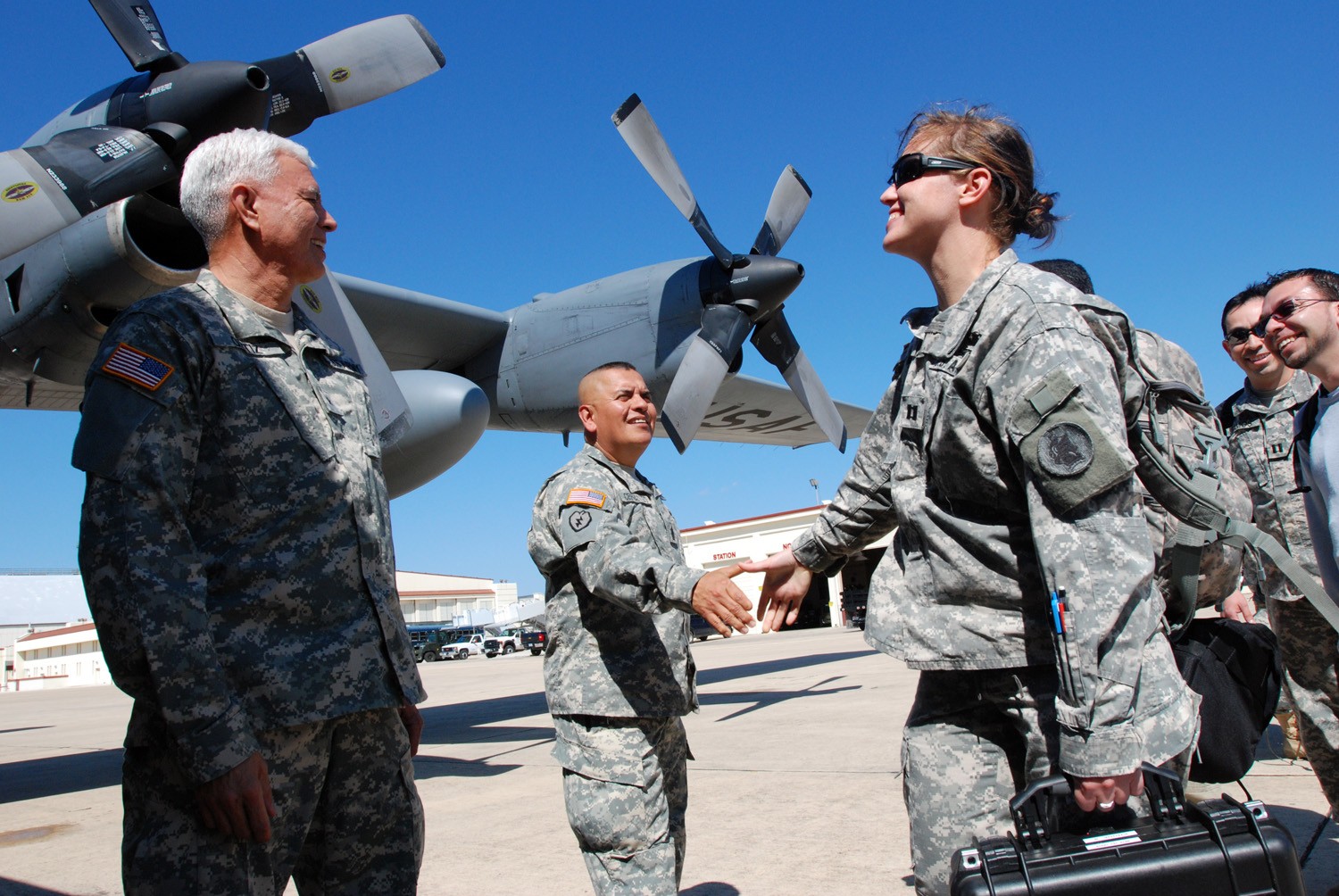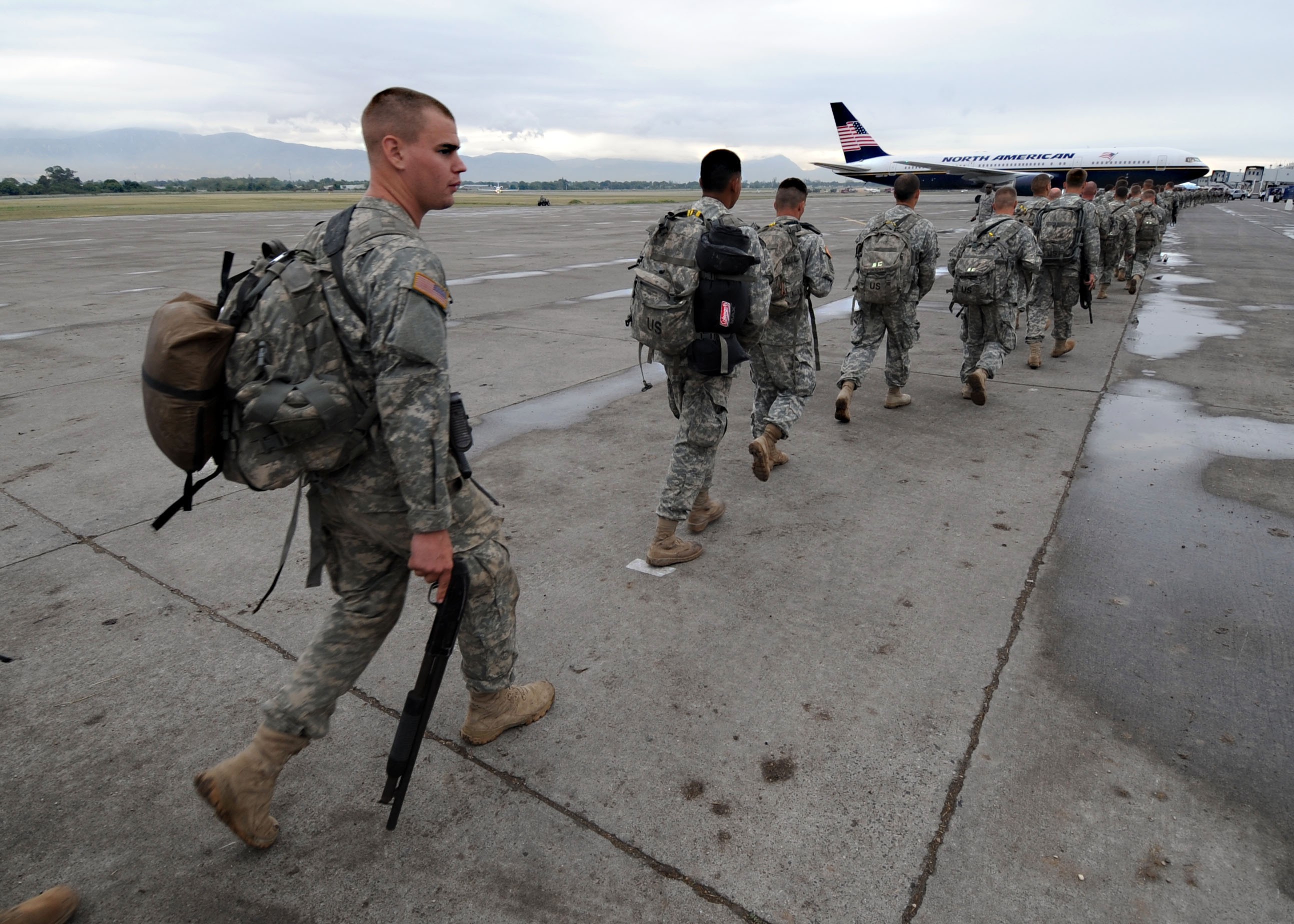Haiti Military - For the military intervention in The Gambia, see Operation Restoration of Democracy. For US intervention, 1915-1934, see US Occupation of Haiti.
The examples and ideas in this article are mostly from the United States and do not conflict with ideas around the world on the subject. You can improve this article, discuss the issue on the talk page, or create a new article as needed. (October 2018) (Learn how and why this template message was removed)
Haiti Military

Soldiers of Company C, 2nd Company, 22nd Infantry Regiment, 27th Engineer Battalion, 10th Mountain Division defend the Port-au-Prince airport on the first day of Operation Uphold Democracy.
How Operation Uphold Democracy Still Affects Life In Haiti
Action Uphold Democracy was a military intervention aimed at overthrowing the military regime established in Haiti by the 1991 coup that ousted elected President Jean-Bertrand Aristide democratically. The operation was effectively authorized by UN Security Council Resolution 940 on 31 July 1994.
The operation began when the United States and its allies issued a warning about entering the island nation of Haiti. Elite units of the US Navy, Coast Guard and Air Force are heading to Puerto Rico and southern Florida to prepare to support an air assault led by elite units from the Joint Special Operations Command
(Headquarters, 75th Ranger Regiment), followed by the 3rd Special Forces Group, the 7th US Army Transport Group (Army Ship and Terminal Units), and the 10th Mountain Division. Some of these elements were held from Hunter Air Force Base and Guantanamo Bay Naval Base. The 1st Brigade, 10th Mountain Division deploys to Haiti aboard USS America and USS Dwight D. Ashore.
The operation was led by Lieutenant General Hugh Shelton, Joint Task Force 120 (JTF-120), assisted by the commander of Carrier Group II.
Soldiers Bring Fresh, Clean Water To Haiti
On September 16, 1994, as these forces prepared to attack, the main guard of the 82nd Airborne Division was already in the air, led by former President Jimmy Carter, Senator of the SA Sam Nunn and Chairman of the Joint Chiefs of Staff Gerald Colin Powell of. the Foreign Affairs Force urged Haiti's president to resign and restore elected officials to power. Gerald Joseph Raoul Cedras is the main leader in power, who was the focus of the delegation. The personal relationship of Geral Powell with Cédras, who, as a young officer studying at the American Academy, won the audience of the dictator at the American delegation and was able to play an important role in negotiating for about two week.
While the US delegation continued its diplomatic efforts and suggested that it would use force if necessary, the talks stopped for now because Gerald Cedras refused to recognize the legitimacy of the democratic elections. In a last ditch effort to get the dictator to step down non-violently, the delegation gave Geral Cédras a video of planes unloading troops from the 82nd Airborne Division, whose DRF-1 (1st Ready Force Division, the first deployment of a designated battalion, its equipment and equipment and The 1st Battalion, 325th Airborne Infantry Regiment "Kestrel" has been sent to Ft. Sherman, Panama. Therefore, the 2nd White Falcon Battalion, 325th Air Force, assigned to 1st Brigade, 1st Battle Readiness Brigade (DRB-1), 82nd Airborne Division.
While allowing Cédras to process the shocking scene, he was told that although he thought he was watching live footage, he was actually watching a video taken over 2 an hour before that. So, ahead of the 3,900-strong paratrooper force

It was launched from Fort Bragg, North Carolina, and is flying across the Atlantic Ocean. They also told him that the United States was committed to supporting democracy and that a forced air attack on the island nation would likely bring Haiti under American control before the next sunrise.
Haiti Relief Surge
The delegation then delivered an ultimatum to the dictator. His choice is to recognize the will of the Haitian people expressed through the democratic elections of Jean-Bertrand Aristide and resign quietly, or continue to undermine the election results; in that case, the United States will forcefully control his country Take control and see justice. did. In order to remove all uncertainty from the general's mind, the delegation reminded him that the 82nd Airborne was also the first to score a major and decisive victory recently in Operation Grada "Emergency Fury" and Panama "Just Cause". Within minutes, Geral Cédras surrendered on what were the best terms for him at the time.
The surrender of Cedras took some time to come to a conclusion, and even after it was completed, it did not immediately become law in the Haitian armed forces; and other members of the junta did not immediately follow. As a result, the US troops landing in Haiti believed that their goal was to separate the leadership of the general government from Fad'H without causing panic among the rank and file soldiers. To make this possible, Gerard Shelton decided to transfer Cedras to the command of Major Gerard Jean-Claude Duperval, who then transferred Aristide to the accepted characters promoted to high positions in Fad'H. Believing that he needs FAd'H in the short term to avoid anarchy, Sheldon decides to gradually reform the group. A sudden collapse, he fears, would unleash a rapid and uncontrolled social decompression that could lead to mass revolution. The rules of the contract in the US are very strict; supporters of the paramilitary junta in FRAPH are considered legitimate political groups and therefore cannot be suppressed unless they strike first. Initially seeing the Americans as liberators, most ordinary Haitians gained a sense of unfulfilled expectations after learning that American soldiers were negotiating and co- work with the Fad'H who was concerned to maintain order in the capital. Many Haitians had expected the United States to retaliate against members of the junta. President Aristide urged him to remain calm until he returned.
In one case on September 20, US Army troops landed directly in Port-au-Prince while a protesting crowd was violently dispersed by Haitian police, resulting in civilian deaths. As things stand, many Haitians do not know who should run the city. The US Army quickly changed its rules of engagement after an outcry from US military and citizens, as well as Haitians. Behind the scenes, Shelton had Colonel Michael Sullivan, commander of the 16th Military Police (MP) Brigade, send a clear message to Port-au-Prince Police Chief Colonel Michel François to stop attacks on the crowd or execute and hold François Sowa accountable.
The US Marines who lived in Cap-Haitien, the second largest city in Haiti, were not so limited; they started looking on foot when they arrived, establishing a strong presence. On 24 September, one such patrol encountered a Fad'H unit believed to be making a "threatening gesture", resulting in a brief firefight: t A Fad'H unit was killed minus the US loss. The event helped establish American authority in the public mind (and was popular when news broke the next day), although it was far from the last violent incident of the occupation. A FRAPH terrorist throws a phase at a ceremony celebrating the reinstatement of popular Port-au-Prince mayor Evans Paul on September 29; the terrorist is arrested and interrogated by Marines the next day.
Flag Of Haiti On Soldier Arm. Flag Of Haiti On Military Uniforms Stock Image
When it surrendered, more than 100 planes carrying the 82nd Airborne turned around in midair or were unloaded before they could take off. The paratroopers returned to the force field at Fort Bragg and began to prepare; it was only on December 12, 1994 that the "Black Panther" task force deployed the DRF-1 to Panama for "safe haven" and "safe passage" operations. With the deployment of the United States, the military's mission changed from combat operations to peacekeeping and nation-building operations led by the multinational force in Haiti. This force consisted primarily of members of the 3rd Special Forces, but also included the 16th Military Police Group, 118th Military Police Company (Fort Bragg, NC), 101st Military Police Company , 988th Military Police Company (Fort Bning, Georgia) and 101st Aviation. Brigade (Ft. Campbell, Ktucky), 3/2 ACR from Ft. Polk, Louisiana and Caribbean Marines. Task forces were deployed across the country to restore order and provide humanitarian services. Regular Army units including the 10th Mountain Division and the 3rd Battalion (Airborne) 73rd Armored Regiment (82nd Airborne Division) and units from the US Army Materiel Command provided the Logistics Support Command (JLSC), responsible for directing and direct control of all multinational corporations. forces and logistics forces used by the United States. This includes the Joint Materiel Management Center, JMMC and the subsequent civilian contractor LOGCAP, including the Advanced Defense Support Group CELL. After that, the 3rd Corps deployed a group of 46th Support Group to support CMMC. In addition, members of the 55th Medical Group 44th Medical Group (Airborne) from Fort Bragg provided medical care to military personnel and Haitians during early deployments. Joint Psychological Operations Task Force (JPOTF) consists mainly of eleemts
Moneygram haiti, us military haiti, haiti military history, haiti military coup, call haiti, haiti organization, haiti relief, servotel haiti, military in haiti, haiti development, unicef haiti, haiti donations
0 Comments